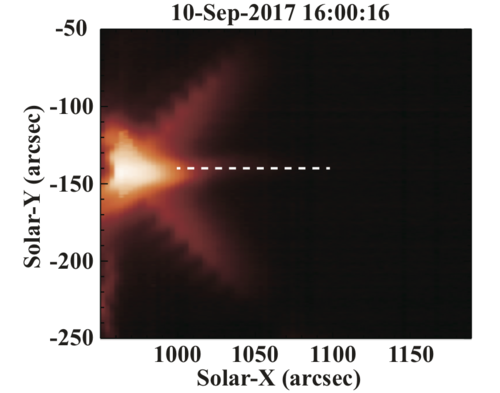Nonequilibrium Ionization of Flare Plasma Observed by Hinode/EIS
From RHESSI Wiki
| Nugget | |
|---|---|
| Number: | 409 |
| 1st Author: | Shinsuke IMADA |
| 2nd Author: | |
| Published: | 14 June 2021 |
| Next Nugget: | STIX |
| Previous Nugget: | Effects of Flares on Solar p-modes |
| List all | |
Contents |
Introduction
In the solar corona, we customarily assume plasma to be in the condition of thermal coronal equilibrium via the effects of Coulomb collisions. In this state, different states of ionization have a distribution governed by the balance between collisional ionization and recombination rates in the plasma. This assumption should prevail in a steady state for an optically-thin medium. But... a solar flare is definitely not a steady state, and so deviations must occur at some level.
Many previous studies have discussed plasma dynamics in solar corona with this assumption of coronal thermal equilibrium. Indeed, most phenomena observed in the solar corona can be explained this way, if only because the temporal resolution is usually not good enough to resolve the non-equilibrium conditions. We had however noted some time ago (Ref. [1]) that that ionization should not reach equilibrium during magnetic reconnection because of the fast flow and rapid heating expected then.
Accordingly solar flares, if powered by reconnection, should be a good place to study non-equilibrium effects. If found, the details will have major diagnostic significance. I have therefore used EUV spectroscopic data from the EIS instrument on the Hinode spacecraft to make a sensitve search, as reported in Ref. [2].
The flare
The powerful flare/CME event of SOL2017-09-10 (X8.3) provided an excellent opportunity. This event has been studied by many authors already (for example, enter the flare name in the search field to find several earlier RHESSI Science Nuggets). The Hinode/EIS observed in a slit-scanning mode over a field of 240x304 arc sec with a 2 arcsec slit and 3 arcsec steps between exposures. To aim specifically at the temperature diagnostics in flare plasma at the highest temperatures, the observations were restricted to only two very hot lines: Fe XXIV and Fe XXIII.
Time-dependent ionization
In order to study plasma heating considering the time-dependent ionization process during a flare, the time evolution of the charge state of iron in the downstream of reconnection outflow was calculated in the same manner as Ref. [1].
Non-equilibrium ionization plasma observed by Hinode/EIS
The time evolution of the charge state of iron in the downstream of reconnection outflow was applied to the Hinode/EIS observation of the large flare on 2017 September 10. The intensity ratio between Fe XXIV and Fe XXIII is shown in Figure 1.
solid line shows the intensity ratio between Fe XXIII and Fe XXIV considering the time-dependent ionization effect with the constant electron temperature Te=25 MK. I assumed the reconnection point is located at X=1100 arcsec, and the plasma is assumed to move downstream (toward X=1000 arcsec) at a rate of 1000 km/s.
Figure 2 shows the intensity ratio Fe XXIV/XXIII along the dashed line, inferred to be the downstream outflow from a reconnection point in the higher corona at about X = 1100 arcsec. The outflow plasma is assumed to move downstream (towards 1000 arcsec) at a rate of 1000 km/s. The observed ratio matches well with a fixed electron temperature of 25 MK and the expected time variation due to the steady increase of ionization level responding to collisions.
Summary and Discussion
I have studied plasma heating considering the time-dependent ionization process during a large solar flare on 2017 September 10 observed by Hinode/EIS. The observed ratios between Fe XXIV and Fe XXIII are consistent with the results of considering the time-dependent ionization effect at a constant electron temperature Te = 25MK. The Solar-C (EUVST) mission currently in preparation has many high-temperature lines and line pairs capable of density diagnosis. We expect that plasma diagnostic studies in the reconnection region will dramatically progress with this new capability.
References
[1] "Magnetic Reconnection in Non-equilibrium Ionization Plasma"
[2] "Spectroscopic Observations of Current Sheet Formation and Evolution"
| RHESSI Nugget Date | 14 June 2021 + |
| RHESSI Nugget First Author | Shinsuke IMADA + |
| RHESSI Nugget Index | 409 + |

